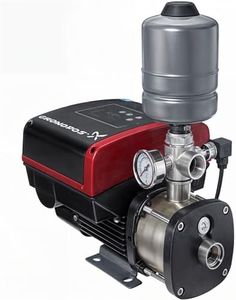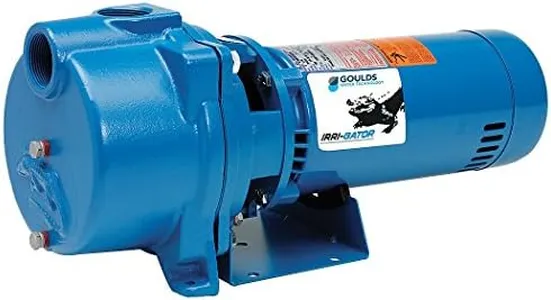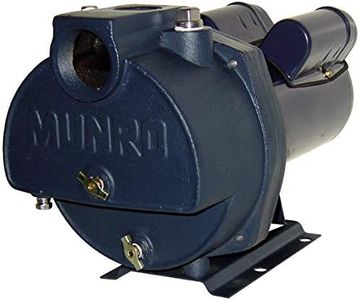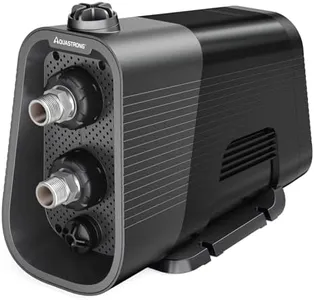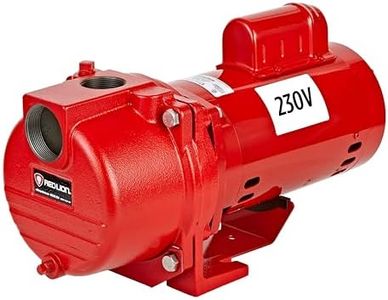10 Best Irrigation Pumps 2025 in the United States
Our technology thoroughly searches through the online shopping world, reviewing hundreds of sites. We then process and analyze this information, updating in real-time to bring you the latest top-rated products. This way, you always get the best and most current options available.

Our Top Picks
Winner
Davey Dynadrive DD15-35NPT 120V Variable Speed Constant Pressure System, 24 gpm
Most important from
11 reviews
The Davey Dynadrive DD15-35NPT is a submersible irrigation pump designed to deliver a steady water flow with a maximum rate of 24 gallons per minute. It maintains consistent pressure even when multiple taps are used, thanks to its programmable pressure setting, which is preset for 60 psi up to 12 gpm. This feature helps avoid sudden pressure changes (water hammer), protecting your plumbing and reducing maintenance needs.
Powered by standard 120V AC electricity, it should fit easily into most home or small farm setups without extra equipment. The pump is made from durable stainless steel, promising good resistance to wear and corrosion over time. Its maximum lifting height of 216 inches means it can push water to fairly high places, making it useful for various irrigation layouts. On the downside, the 24 gpm flow rate may be on the lower side for large-scale irrigation, and running at 9.4 amps means it might increase electricity costs compared to smaller pumps.
This pump is ideal for homeowners or small farms needing reliable, constant pressure irrigation with moderate water demand and easy installation.
Most important from
11 reviews
Grundfos 98810924 CMBE 3-51, 115V Booster Pump
Most important from
3 reviews
The Grundfos 98810924 CMBE 3-51 Booster Pump is a robust and efficient choice for various water supply needs, particularly in irrigation systems. With a flow rate of 16.3 gallons per minute (GPM) and a maximum pressure of 145 PSI, it can handle substantial water demand. The pump's total head lift of 161 feet and suction head of 23 feet make it suitable for diverse applications, including light commercial settings and residential irrigation systems. Powered by a corded electric source at 115 volts, its 1 HP motor is both powerful and energy-efficient, thanks to the frequency-controlled permanent-magnet motor and integrated speed controller that ensure constant pressure and optimal performance.
The Grundfos pump's stainless-steel construction offers excellent durability, corrosion resistance, and dry-running protection, guaranteeing long-lasting use and reduced maintenance needs. NSF 61/372 approval for drinking water applications adds an extra layer of safety. User-friendly features include a preassembled system, simplified installation with a 5-foot power cord and a 3-prong plug, and straightforward operation via the Grundfos Eye Control Panel and compatibility with the Grundfos GO mobile app for remote monitoring.
The pump operates quietly, below 55 dB(A), which is ideal for residential use. However, it may not be suitable for users looking for a budget-friendly option, as its advanced features and construction materials can make it relatively expensive. In summary, this booster pump is a reliable and versatile solution for those needing efficient water pressure management in irrigation and other water supply systems.
Most important from
3 reviews
GOULDS Pumps GT15 IRRI-Gator Self-Priming Single Phase Centrifugal Pump, 1.5 hp, Blue
Most important from
450 reviews
The Goulds Pumps GT15 Irri-Gator is a self-priming centrifugal pump designed for irrigation and water transfer applications. With a power of 1.5 horsepower, it delivers a maximum flow rate of 64 gallons per minute, making it suitable for medium to large gardening or irrigation needs. One of the standout features is its self-priming capability, which saves time and effort when setting it up for use. Users will appreciate the fully serviceable design, allowing for easy maintenance and repair, which can extend the pump's lifespan significantly.
Additionally, the use of corrosion-resistant materials like stainless steel and cast iron enhances its durability, especially in tough outdoor conditions. Its FDA compliant impeller ensures safety and reliability when used for water sources that may come into contact with plants or food.
On the downside, the pump operates at 230 volts, which may require specific electrical outlets, limiting its use in areas without proper electrical infrastructure. Weighing 60 pounds, it’s relatively heavy, which might make mobility a challenge for some users. Also, while the maximum lifting height of 25 feet is adequate for many applications, it may not be sufficient for all scenarios, particularly in large-scale agricultural setups. This pump is ideally suited for homeowners with gardens, hobby farmers, or anyone needing reliable irrigation solutions, though users should ensure they have the appropriate electrical setup and consider the weight when moving it around.
Most important from
450 reviews
Buying Guide for the Best Irrigation Pumps
Choosing the right irrigation pump is crucial for ensuring that your plants receive the right amount of water efficiently. The right pump can save you time, energy, and water, while also promoting healthy plant growth. When selecting an irrigation pump, it's important to consider several key specifications to ensure it meets your needs. Understanding these specifications will help you make an informed decision and select the best pump for your irrigation system.FAQ
Most Popular Categories Right Now

